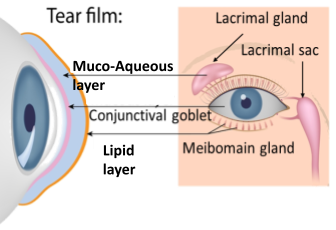

Dry Eye Disease (DED) is a multi-factorial condition that is difficult to diagnose, in part due to the limitations of objective and subjective testing methodologies. Currently, eye care providers utilize several different tests (some of which are invasive) to measure DED signs (objective) and symptoms (subjective); however, they often show little correlation.
DED is either caused by decreased tear production or increased tear film evaporation. Both phenomena are associated with the volume and composition of the aqueous sublayer of the tear film. There are currently NO single noninvasive methods which can accurately and objectively measure all relevant tear film sublayers including the aqueous sublayer.
What is Dry Eye Disease
Dry eye disease is a common condition that occurs when your tears aren't able to provide adequate lubrication for your eyes. Tears can be inadequate and unstable for many reasons. For example, dry eyes may occur if you don't produce enough tears or if you produce poor-quality tears. This tear instability leads to inflammation and damage of the eye's surface.
Dry eyes feel uncomfortable. If you have dry eyes, your eyes may sting or burn. You may experience dry eyes in certain situations, such as on an airplane, in an air-conditioned room, while riding a bike or after looking at a computer screen for a few hours.
Signs and symptoms, which usually affect both eyes, may include:
- A stinging, burning or scratchy sensation in your eyes
- Stringy mucus in or around your eyes
- Sensitivity to light
- Eye redness
- A sensation of having something in your eyes
- Difficulty wearing contact lenses
- Difficulty with nighttime driving
- Watery eyes, which is the body's response to the irritation of dry eyes
- Blurred vision or eye fatigue
Causes
Dry eyes are caused by a variety of reasons that disrupt the healthy tear film. Your tear film has three layers: fatty oils, aqueous fluid and mucus. This combination normally keeps the surface of your eyes lubricated, smooth and clear. Problems with any of these layers can cause dry eyes. Reasons for tear film dysfunction are many, including hormone changes, autoimmune disease, inflamed eyelid glands or allergic eye disease. For some people, the cause of dry eyes is decreased tear production or increased tear evaporation.
Anyone can get dry eyes, but you might be more likely to have dry eye if you:
- Are aged 50 or older
- Are a female
- Wear contact lenses
- Don’t get enough vitamin A or omega-3 fatty acids
- Have certain autoimmune conditions, like lupus or Sjögren syndrome
Currently it is believed that more than 300M people suffer from dry eye disease on a global basis.
Improved diagnosis of the tear film structure and its deficiencies will enable medical professionals to better monitor and tailor the dry eye treatments to the individual patient.

